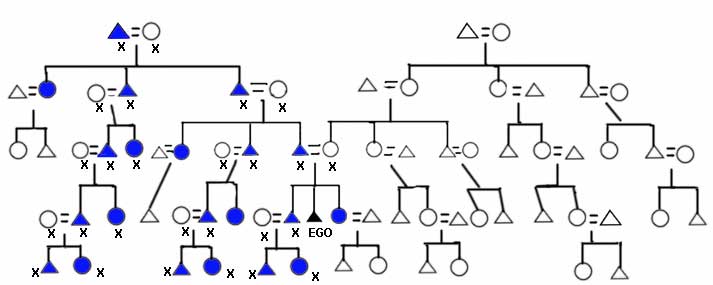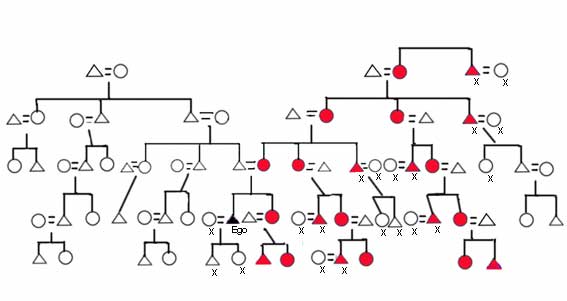Post Marital Residency
Post-marital residency refers to where the bride and groom go to live after the wedding, with respect to the bride's parents and family and the groom's parents and family. Particularly in unilineal descent systems, it is very much correlated with type of descent.
Neolocal Residency
In the United States, where are the newly married couple expected to live with respect to the parents of the bride and groom? The answer is that they are expected to found a new household apart from either set of parents, since presumably their main priority should be each other, and not the parents. In fact, some Americans, if asked how far away the new household should be from both sets of parents, will respond "As far away as possible!" That does not mean that the couple forget their parents, but simply that their major focus is on their nuclear family of procreation, as defined in the text. The form of post marital residency where the bride and groom live apart from either set of parents and family is termed neolocal. Neolocal residency seems particularly adapted to the economic demands of the industrial mode of production, with its need for small households that can move easily depending on production needs.
Patrilocal Residency
The most common post marital residency form is patrilocal, where the newly married couple go to live with or near the groom's family. It was present in many bilateral foraging societies, such as the San, and in patrilineal cultures ranging from horticultural to industrial. It is present in the traditional Hmong, in the Yanomamo, in the Tiv, and in the Nuer. It is present today in much of the world, including China. In areas that are industrializing rapidly, such as China, it is also changing, and neolocal residency is becoming more common.

Modern Bride in Rural China, on Way to Husband's Kin Group
Clearly the effect of patrilocal residency is to focus the attention of the newly married couple on the husband's kin group, and this is why it is so common in societies with patrilineal descent. In many east Asian patrilineal cultures, the bride actually joins the husband's patrilineage upon marriage. Even in the many other culture's where she remains a member of her own patrilineage, her focus and responsibilities are still to her husband's (and her children's) patrilineage. Patrilocal descent combined with patrilocal residency mean that members of the patrilineage are living together, and thus can easily hold property, such as land and houses, in common. In other words, the patrilineage has many corporate functions.

An X Indicate the People Living Together in Patrilocal Residency
As the illustration above indicates, the male members of the patrilineage, their wives and unmarried sons and daughters will be in residence on the land owned by the patrilineage. When a son marries, his wife will move in. When a daughter marries, she will move to live with her husband's patrilineage, and to bear children for her husband's patrilineage. It is for this reason that brideprice is so often associated with patrilineal descent and patrilocal residency; the woman's patrilineage is losing both her labor and her children when she marries and move's to her husband's patrilineage.
Matrilocal Residency
Matrilocal residency, where the bride and groom go to live with or near the bride's parents and family, is highly correlated with matrilineal descent.
The X's Indicate the People Living Together with Ego in Matrilocal Residency
As the illustration above indicates, matrilocal residency puts the women of the matrilineage together on the land and property that was owned by the lineage, or to which the lineage had "use rights". In cultures such as the Iroquois, who were both matrilineal and matrilocal, this gave women a great deal of power and influence. Members of a matrilineage often literally lived together in the same "long house", and the adult men were all married into the matrilineage. Divorce was easy for women, since if a particular man turned out to be lazy, a trouble-maker, or abusive in some way, divorce was as easy as piling his personal belongings outside the long house. The divorced man did have some place to go however: back to the long house of his own matrilineage.
Matrilocal residency was particularly common in matrilineal cultures where men were frequently away from home due to warfare or prolonged hunting trips. Both were true for the horticultural Iroquois chiefdom. (Remember, American horticulture was largely without domesticated animals: see first lesson in the unit.)
Ego in the above diagram is of course shown as unmarried; when he marries, he must move to his wife's matrilineage. He often retains certain obligations to his own matrilineage, including his closest kin of the next generation, his sister's children. Perhaps for this reason, there is no exact reverse equivalent of brideprice or bridewealth in matrilineal, matrilocal cultures. (Dowry, remember, is something quite different.)
Avunculocal Residency
In avuculocal residency, when a couple was married, they went to live with or near the groom's mother's brother. Avuculocal residency is found only in cultures with matrilineal descent, and usually is also correlated with a lack of long-distance travel for men either for warfare or hunting. Look carefully at the diagram below. As you will see, avuculocal residency means the males of a matrilineage in residence on (and hence in control of) the land and property of the lineage. When our male Ego below marries, he will go to live with his mother's brother or brothers, along with all other married adult males of the lineage. Ego's wife will go with him, and his children will be raised there. When his children are grown, the sons will go to live with their mother's brother, and the daughters will go to live with their husband's mother's brother. However, Ego's sisters' sons will move in with him upon marriage. (Not to complicate things, but if Ego marries his maternal cross cousin --mother's brother's daughter--he will just move in with his bride and her father--his mother's brother! And Ego's own sister's son may marry Ego's daughter!)

Avunculocal Residency (Everyone with an X is living with Ego, who is shown as married in this diagram.)
|